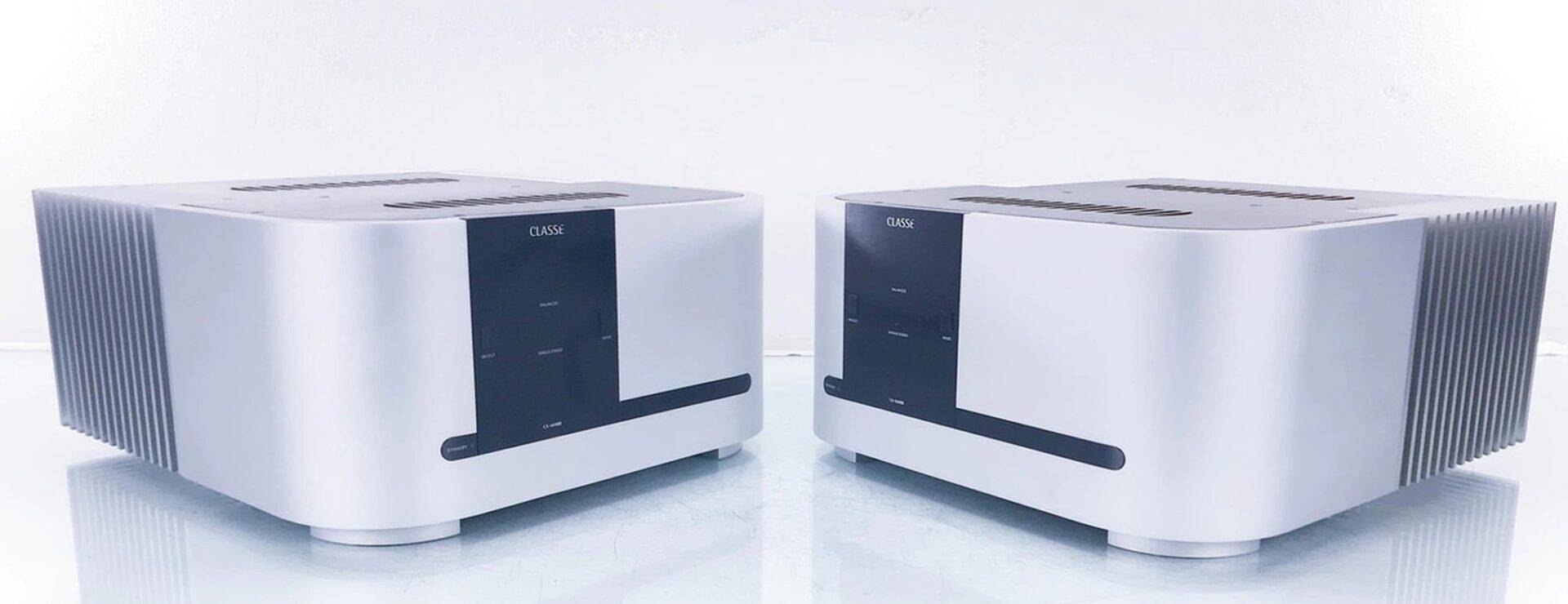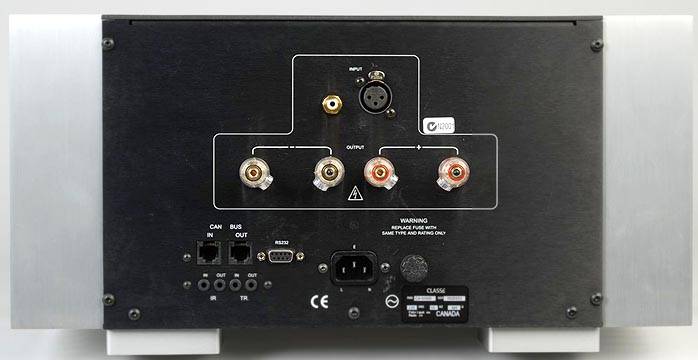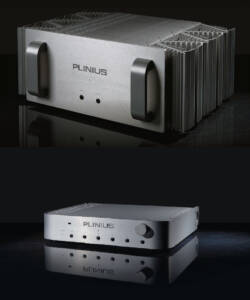Classe CAM-400 Monoblock Power Amplifiers
Original price was: R180,000.00.R94,000.00Current price is: R94,000.00.
 |
|||||||||||||||
 |
|||||||||||||||
| It’s one of the best endorsements in the world of high-end audio when a company’s product is chosen by a world-leading recording studio as the in-house reference. So it is with the amplification behemoths on review here, the Classé CA-M400 monoblock amplifiers from Canada; Abbey Road Studios’ amplifier of choice for a number of their famous recording rooms. In fact, the very pair at hand, prior to their arrival, were in situ at a Sydney-based studio where some months ago they performed amplification duties during the production of the Happy Feet soundtrack, amongst many others.
|
|||||||||||||||
| Upon receiving these amplifiers, I was struck straight off by the quality and solidity of the packaging. No mere cardboard boxes here. I’m talking about a | |||||||||||||||
| rib-reinforced box of plastic-type material that can not only take the unit’s weight but also support and protect it against the clumsiest of couriers. What’s more, unpacking the rather heavy amplifiers is a breeze (well, almost); there’s no turning the box upside down, no re-tipping the amp back up etc. The box simply disassembles and collapses around its contents – or assembles around the product when packing it back up. If more heavy products were packaged in this manner, there would be a lot of reviewers around with healthier backs. This level of care goes some way towards establishing a buyer’s sense of confidence in a product that reflects an overall philosophy of quality, extending from packaging to the product itself.
|
|||||||||||||||
Enough about packaging. The CA-M400 amplifiers are an example of industrial design at its pinnacle. The aesthetics are simple and clean yet very elegant and the design theme is carried through to the company’s numerous other products. The thick and solid natural aluminium fascia curvaceously bends around towards the rear at the sides without a wrinkle or blemish in sight — this is quite difficult to achieve when thick aluminium is curved in such a manner –as it meets the extensive custom heat-sinking and solid steel chassis. A contrasting black-anodized aluminium control panel is off-centred and is host to the stand-by/on, mode and select buttons. |
|||||||||||||||
 |
|||||||||||||||
In conjunction, the mode and select buttons are used to control and configure the amplifier for either balanced or single-ended operation. They also manage the configuration for the turn-on delay or amplifier number (in multi-amplifier set-ups) for connection with a Classé preamplifier. The rear of the amplifier includes RCA single-ended and XLR balanced inputs which can be connected simultaneously and switched via RS-232 or the front panel. There’s two sets of speaker outputs for bi-wiring and 3.5 mini-jack communication sockets in addition to the above-mentioned RS-232 connectors. The attention to detail even extends to the amplifier’s feet which are substantial aluminium footers with a specialized rubber vibration-absorbing compound insert. |
|||||||||||||||
 |
|||||||||||||||
Each solid state Classé CA-M400 weighs 37kg and is rated at a powerful 400 watts RMS at 8 ohms and doubles-up to 800 watts into 4 ohms (not measured 20Hz-20Khz but at 1Khz). Voltage gain is 29.1dB and signal-to-noise ratio is a healthy 112dB. Oddly, input impedance – crucial for proper preamplifier matching – is not specified either on the website or the otherwise very informative instruction manual where mention is made of their easily-driven input stage. |
|||||||||||||||
 |
|||||||||||||||
Classé’s designers chose to use a number of technologies where they thought they benefited the overall design most appropriately. The input stage uses J-FET devices that are utilized because of their high input impedance and low offset current. As a result, Classé amplifiers are easy to drive and exhibit low-noise, and the J-FET input stages don’t necessitate the use of sound-degrading coupling capacitors. The driver and output stages use a combination of MOSFETs and bipolar devices so as to achieve what Classé’s engineers consider the ideal balance for great sound. Each amplifier houses a massive custom toroidal transformer amongst other robust power supply componentry. The CA-M400s also incorporate extensive self protection against DC voltage, overheating and all other manner of potential mishaps.Befitting Classé’s philosophy, many of the above design decisions were arrived at after extensive subjective listening tests backed by comprehensive laboratory-bench measurements. |
|||||||||||||||
| Listening Impressions Slotting the amps in our system was a matter of plonking them on spiked timbre platforms on the floor in front of the Finite Elemente equipment racks, as these monsters are physically enormous. I ran the amps both in balanced and single-ended modes.Sonically, one thing that’s noticeable straight off the bat is the Classés’ smoothness throughout the midband and top end. The amps manage a balancing act that retains resolution and separation of musical strands while maintaining a level of detail that impresses. There’s no grain or etch here, none of that ‘coldness’ that is sometimes evident in technically complex high-powered solid state amplifiers. |
|||||||||||||||
Jazz ensemble recordings are a great medium to test and reveal these particular qualities. In the Round Midnight soundtrack, a Herbie Hancock production, a group of musos is headed by Hancock himself and tenor saxophonist Dexter Gordon, all apparently recorded live within the film set, an authentic reproduction of the real-life Blue Note Jazz Club. Here the CA-M400 amps revealed all the instruments in tight focus and in an airy space within the wide and deep soundstage. Herbie is on a large-sounding and tonally accurate piano, Dexter’s sax is equally well reproduced and really swings dynamically.Playing the wonderfully re-mastered JVC XRCD version of Lightin’ Hopkins’ Goin’ Away (originally recorded in 1963), Lightnin’s deep vocal growl was rendered with precision and accuracy as if the man and his guitar were placed in our listening room. If your speakers are up to it, then the Classé amps will deliver the full measure of information. Bass guitar and stand up bass packed a real punch with these amps. It’s here that the massive power supply contained within really proves its worth. All bass-heavy music was controlled and powerful. |
|||||||||||||||
 |
|||||||||||||||
The CA-M400 amplifiers performed outstandingly in all areas, however being a seasoned nitpicker, I noticed a deficiency in PRaT or Pace, Rhythm and Timing. For example, Porcupine Tree’s well-produced In Absentia has an opener that could easily make the top 50 all-time best guitar intros. The CA-M400s ever so slightly slowed the rhythm and pace, taking the edge and tension off this killer rock riff. This is only noticeable when compared to some valve and class-D designs that excel at speed. At the time, my reference system featured the Wilson WATT/Puppy System 6 (I have since upgraded to the current System 8 and all I can say at this juncture is, whoa!), very revealing speakers coupled to the extraordinarily dynamic and fast Nuforce Reference 9 SE V2 analogue switching amplifiers. Only when compared within this context was the PRaT issue evident. However, I experimented a little further. For those “cables don’t make a difference” doubters, a change to a short run of reasonably priced silver cable almost totally redressed the PRaT situation. Returning to the Porcupine Tree’s killer riff now had me toe tapping and air drumming to an improved sense of transient attack and pitch accuracy. And this increased rhythmic flow applied to the frequency range at large and serves to highlight the CA-M400s’ revealing and accurate sound when mated to appropriate speakers and ancillaries. |
|||||||||||||||
 |
|||||||||||||||
Classical music was reproduced superbly via the Classé amps. Recording permitting — as in Decca Legend’s recording of Solti conducting Beethoven’s 3rd — such music sounded powerful and dynamic and orchestras were placed within a vivid semblance of the venue in which they were recorded. The instrumental groups were clearly resolved by the amplifiers, greatly enhancing the impression of being at a live performance. Similarly, with chamber ensembles as illustrated on the Wilson Audio label recording of Debussy and Bartok sonatas, the Classé amps were captivating in the way they separated and resolved the piano, violins and cello, all with realistic detail and presence.A classy act The Classé CA-M400 monoblock amplifiers are superbly built and — as far as amplification devices go — comprehensively featured. They have the hallmarks of expertly engineered electronics and they are bound to last a lifetime. What’s more, they have an engaging sound that is dynamic, smooth throughout the frequency range, accurate in detail and spatially massive. Classy indeed. |
|||||||||||||||
Classé Audio CA-M400 Mono Amplifier Reviewed

In the past decade-plus of reviewing topnotch audiophile and home theater gear, I can think of few products that have caught my attention more than the Classé’ Audio CA-M400 monoblock amps. Priced at $5,000 each or, as reviewed, $10,000 per pair, the Classé’ CA-M400 is certainly expensive but still not anywhere near the price of top-of-the-line audiophile reference amps from the likes of Krell (Evolution), Halcro and Mark Levinson. Upon first glance, you can’t help but to be impressed with the industrial design of the Classé CA-M400. Its rounded edges and off-while/silver coloring, dressed with stylish black trim, makes the amp look like it belongs in the Museum of Modern Art, as well as potentially on the floor of your listening room.
Additional Resources
• Read more amplifier reviews from HomeTheaterReview.com’s staff.
• Find some audiophile speakers to match the caliber of the CA-M400.
Getting past looks, the Classé CA-M400 is a 400-watt powerhouse that has a clean, open sound. The highs aren’t overly warm, but have a nice air to them. The mids are what really sing about the Classé CA-M400. Its ability to reproduce vocals, especially female vocals, and specifically complex piano pieces, is most noteworthy. The bass on the Classé CA-M400 is also very noteworthy. While not as bombastic as, say, a Krell amplifier, the Classé’s 400 watts per channel can take any speaker, in my case, the often tough-to-drive Revel Ultima Salon2 loudspeakers, and power them with ease to rock concert volumes. Overall, the sound of the Classé CA-M400 is very well balanced.
High Points
• The Classé’ Audio CA-M400 offers ultimate audiophile monoblock performance, on par with the most expensive options from Krell, Mark Levinson and Halcro, at a fraction of the price.
• The fit and finish of the Classé Audio CA-M400 is as good as you
will find anywhere with any audiophile product. It is simply stunning
and anyone who tells you that you are being too foo-foo about
considering the way an amp looks can kiss your ass. The look of a
statement amp like the Classé’ CA-M400 matters.
• I love the
midrange performance of this amp. Some people are bass freaks. Others
want a little more brightness on the high end, but take my word, and
audition the Classé’ Audio CA-M400 with Sgt. Pepper’s at your local
dealer or, even better, at home, and you will know what I am talking
about. This is a serious audiophile amp.
Low Points
•
While this is nitpicking, the Classé’ Audio CA-M400 is so well balanced
that no one thing really sticks out about it. With a Krell amp, I can
say it has the best bass. With an Audio Research reference tube amp, I
can talk about the magical highs. With the Classé’ Audio CA-M400, the
performance of the amp is so consistent that there is no one element
that jumps out. You will have to decide if that is a plus or a minus
before you make the investment.
Conclusion
I know you are going to think I am crazy, but I believe the Classé’
Audio CA-M400, at $10,000 a pair, is an outright audiophile bargain.
Yes, you can buy a NuForce digital amp for a fraction of the cost,
which is a very nice option at its price point. However, when you are
nearing the top-of-the-food-chain prices for audiophile gear, things
start to get stupid expensive – think NetJets stupid. You do not need
to have a 25-hour card with a Hawker 800XP to be able to afford the
Classé Audio CA-M400. You just need an audiophile system that strives
to reproduce music in your listening room that can legitimately make
you believe the performers are actually in the room, or you need a home
theater system with the latest surround sound codecs like Dolby TrueHD
and or DTS Master Audio that can resolve detail you never thought was
possible across seven channels of surround sound. In the end, the
Classé Audio CA-M400 is about as good of a reference power amp as you
can buy at a fraction of the price of the uber-reference mono amps
currently on the market today.
Description
Specifications
Power output: 400 watts into 8Ω (mono)
Frequency response: 10Hz to 22kHz
Total harmonic distortion: 0.003%
Gain: 29.1 dB
Input sensitivity: 2V
Signal to noise ratio: 112dB
Speaker load impedance: 4Ω (minimum)
Dimensions: 445 x 222 x 470mm
Weight: 37kg











